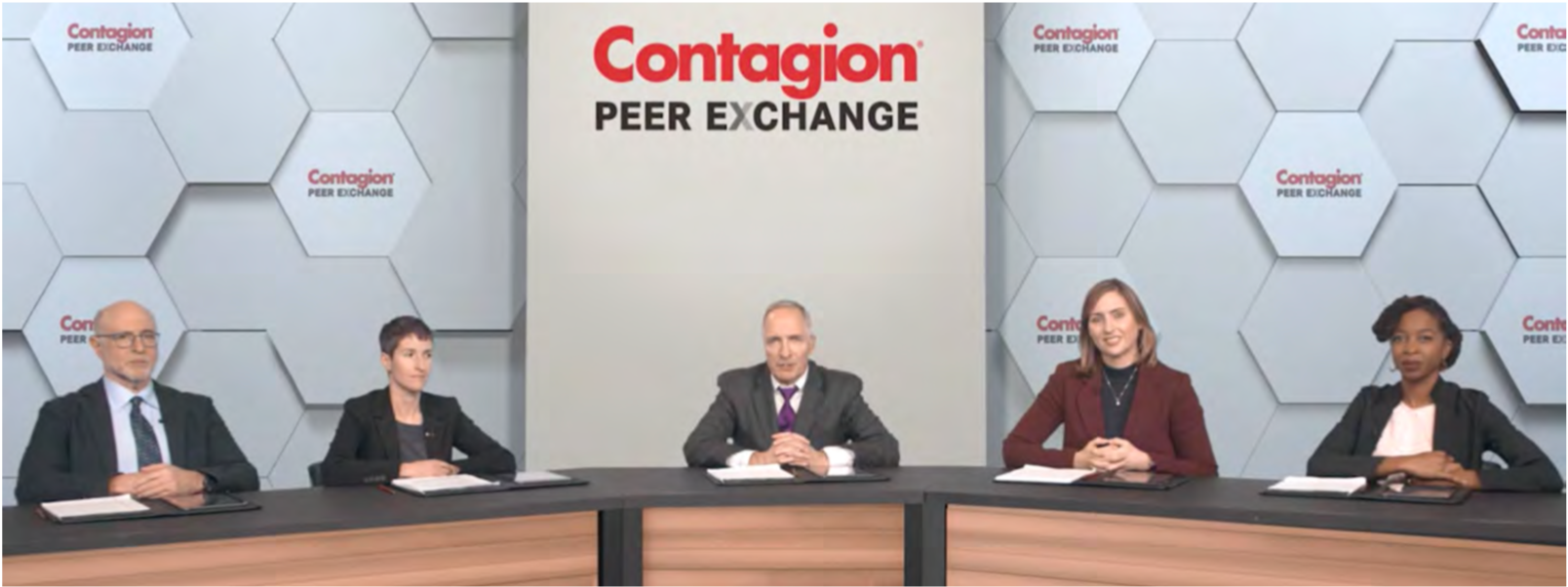Emerging Options for Treatment and Prevention of HIV Infection
An expert panel discussion around long-acting injectables' role in both preventing and treating HIV.

Moderator
Joseph Eron, MD
Professor of Medicine, Division of Infectious Diseases
University of North Carolina School of Medicine
Chapel Hill, NC
Panelists
Allison L. Agwu, MD, ScM
Associate Professor of Pediatric and Adult Infectious Diseases
Johns Hopkins University School of Medicine
Baltimore, MD
Ian Frank, MD
Professor of Medicine
University of Pennsylvania Perelman School of Medicine
Philadelphia, PA
Colleen F. Kelley, MD, MPH
Associate Professor of Medicine, Division of Infectious Diseases
Emory University School of Medicine
Atlanta, GA
Julia Marcus, PhD, MPH
Infectious Disease Epidemiologist
Associate Professor, Department of Population Medicine
Harvard Medical School and Harvard Pilgrim Health Care Institute
Boston, MA
New antiretroviral drugs with unique mechanisms of action and delivery provide promising options for treatment and pre-exposure prophylaxis (PrEP) of HIV infection and may improve adherence in certain subgroups of individuals. However, the development of an effective vaccine remains elusive, according to experts who participated in a recent Contagion® Peer Exchange panel.
Emerging Treatment Options for HIV
Fostemsavir (formerly BMS-663068/GSK3684934), a prodrug whose active metabolite (temsavir) is a first-in-class attachment inhibitor that binds directly to the viral envelope glycoprotein 120 near the CD4+ binding site,1 was approved by the FDA on July 2, 2020, for adults living with HIV who have tried multiple HIV medications and whose infection cannot be treated with other therapies because of resistance, intolerance, or safety reasons.2 This approval was based largely on results from a phase 3 trial, which showed a virologic response (HIV-1 RNA <40 copies/mL) at week 48 in 54% of patients with heavily pretreated, multidrug-resistant HIV infection who received fostemsavir plus optimized background therapy.3 Session moderator Joseph Eron, MD, said that its oral dosing is advantageous over ibalizumab, which is dosed intravenously, although he said that fostemsavir will probably be limited for patients with few or no treatment options.
Allison Agwu, MD, added that long-acting injectable and oral agents, capsid inhibitors, and monoclonal antibodies are also being studied in the HIV space, as are alternative delivery approaches, such as subcutaneous injections, pumps, implants, and patches. However, she pointed out that access to and the cost of these novel options will be key issues moving forward, particularly when currently available oral agents are highly effective for suppressing HIV viral load in the majority of cases.
“The discussions we’ll have to have on how and who and where are going to be very important,” said Agwu. “It doesn’t mean we shouldn’t have those discussions because for the people who are living with HIV, these are maybe life-saving, game-changing remedies for them.”
Long-Acting Injectable Therapies to Treat HIV
The panelists discussed potential uses and challenges with the long-acting injectable therapy containing cabotegravir (an HIV-1 integrase strand-transfer inhibitor) and rilpivirine (a non-nucleoside reverse-transcriptase inhibitor), which is injected in 2-mL doses in the gluteus medius every 4 weeks for the maintenance of virologic suppression in patients who are initiating or transitioning therapy. Although the FDA declined to approve the combination in December 2019 due to concerns related to chemistry manufacturing and controls, the drug manufacturer (ViiV Healthcare) stated that no related safety issues have been reported and the safety profile of the products has not changed. ViiV Healthcare submitted another new drug application that was accepted in April 2020.
Colleen Kelley, MD, said that a benefit of long-acting injectable dosing is that it may help reduce the internalized stigma for many individuals living with HIV who take a daily oral medication. “It’s a constant reminder when you have that pill bottle on your bathroom stand that says, ‘I am HIV positive,’” she noted.
However, the panelists pointed out potential drawbacks with long-acting injectables, such as the risk for drug resistance in patients who miss injections and the possible need to modify the clinic set-up to ensure availability of nursing staff when patients are receiving injections.
“Although there may be some adherence problems that get solved by the injections, I think that there are other adherence risks that get created,” said Ian Frank, MD. “It’ll be more incumbent upon us as providers to ensure that our patients are coming in at the appropriate frequency, and we may need to modify our practices.”
Long-Acting Injectables as Pre-Exposure Prophylaxis
Long-acting injectable therapy with cabotegravir may provide a discreet option for PrEP that does not require daily dosing, according to a recent interim analysis of the phase 2b/3 HPTN 083 trial (NCT02720094).4 The interim results from the trial showed that cabotegravir injection every 8 weeks was superior to daily oral emtricitabine/tenofovir (Truvada) for preventing HIV acquisition in cisgender men who have sex with men and transgender women who have sex with men.4
To have population-level effectiveness, long-acting injectable PrEP needs to cater to a population of individuals who are eligible for and interested in receiving it but are not interested in daily oral PrEP, according to Julia Marcus, PhD. “If the only people who are interested in long-acting PrEP are people who are already taking daily PrEP…it’s not going to have any population-level effectiveness,” she said.
Marcus added that identifying individual barriers to receiving oral PrEP is important to assess whether long-acting injectable PrEP is appropriate for them, noting that it would be more likely to benefit an individual who forgets to take daily medications than one who has difficulty with coming into the clinic.
“If their [issue is] that they don’t want to be coming into the clinic every 3 months, long-acting injectables may not help them,” she said. “They may have to come in even more.”
Other individuals who may be good candidates for long-acting injectable PrEP include those for whom having oral medication may put them at risk for bodily or emotional harm, such as people in unequal power relationships, commercial sex work, or homeless living situations, said Eron and Marcus. Individuals who use injectable drugs or are on methadone maintenance may also be good candidates for PrEP if they come in frequently for syringe changes, said Marcus.
Agwu added that long-acting injectable PrEP could also expand the options in the armamentarium for a given patient at different times of their life.
“If a patient has to go abroad for 2 months, maybe that’s the time to get your shot,” she said. “You don’t have to worry about taking your pills to Morocco.”
She said that further work is needed to optimize system and administration issues and improve practices for delivering long-acting injectable therapy in the clinic. Eron concluded that further research to ensure the efficacy and demedicalization of PrEP is important to improve uptake, as the perception that PrEP care is more intensive than HIV care continues to persist among individuals who are eligible for PrEP.
Preventative and Therapeutic HIV Vaccines
Although the phase 2b/3 HVTN702 trial (NCT02968849), which studied the RV144 Thai vaccine regimen for the prevention of HIV infection in South Africa, was recently discontinued because of a lack of efficacy, Kelley said that this outcome does not mark the end of the journey for finding an effective vaccine, which will be the key to ending the HIV epidemic.
“There’s still more work to be done and no reason to lose hope,” she said. “We’re thinking about monoclonal antibodies and long-acting antiretrovirals in place of a traditional vaccine.”
Kelley said that researchers are getting closer to identifying what the immune system needs to do to protect itself from HIV infection. “If these neutralizing antibodies are the key, how do we make our human immune system create those neutralizing antibodies? ….That’s been extremely difficult to do,” she said. “We can make the antibodies outside the person, but we can’t make the person produce the antibodies. This is the biggest barrier right now.”
Frank added that therapeutic vaccines are also being investigated as a strategy for curing HIV, with “cure” defined “in the context of doing something other than requiring people to take regular antiretroviral therapy to control the virus replication.” Specifically, the goal of a therapeutic vaccine is to improve the individual’s immune response against the infection to enable the withdrawal of antiretroviral therapy and promote an improved immune response to control virus replication, said Frank. He concluded that although therapy and prevention continue to improve, the absence of an effective vaccine and a cure are “the real vacuum” in HIV prevention and treatment, respectively.
Advice for Physicians Treating Patients with HIV
At the conclusion of the exchange, the panelists discussed tips for physicians in the screening, diagnosis, and treatment of patients living with HIV. Agwu stressed the importance of asking patients about risk factors for HIV, including sexual activity, and testing and offering PrEP for patients at high risk. Kelley added that in addition to routine discussions about sexual health, maintaining consistency in the treatment of each patient and identifying other issues that are common to those living with HIV, such as other sexually transmitted infections, is important.
Marcus added that discussing sexual health in an open-ended, nonjudgmental, patient-centered way is important for optimal communication with patients and that communicating the U = U (undetectable = untransmissible) message can be “transformative” for them.
Frank concluded that although undetectable viral load is often the primary focus of antiretroviral therapy, providers should also consider additional factors, such as comorbid conditions, when optimizing HIV therapy and managing overall care for patients.
“It’s important that we remind our patients that they may have other medical conditions, or they may develop other medical conditions, and those medical conditions may pose as great a risk, if not a bigger risk, than their HIV disease,” said Frank. “I have many patients with uncontrolled hypertension and uncontrolled diabetes and lipids that are high. I tell them that they’re going to die of a heart attack or a stroke or be on dialysis long before they ever get a complication of their HIV. Dying of a heart attack with an undetectable viral load isn’t my goal of their treatment. It’s not just about their HIV.”
References
1. Langley DR, Kimura SR, Sivaprakasam P, et al. Homology models of the HIV-1 attachment inhibitor BMS-626529 bound to gp120 suggest a unique mechanism of action. Proteins. 2015; 83(2):331-350. doi:10.1002/prot.24726
2. FDA approves new HIV treatment for patients with limited treatment options. Press release. FDA. July 2, 2020. Accessed October 13, 2020. https://www.fda.gov/news-events/press-announcements/fda-approves-new-hiv-treatment-patients-limited-treatment-options.
3. Kozal M, Aberg J, Pialoux G, et al; BRIGHTE Trial Team. Fostemsavir in adults with multidrug-resistant HIV-1 infection. N Engl J Med. 2020;382(13):1232-1243. doi:10.1056/NEJMoa1902493
4. Long-acting injectable form of HIV prevention outperforms daily pill in NIH study. News release. National Institutes of Health. July 7, 2020. Accessed October 13, 2020. https://www.nih.gov/news-events/news-releases/long-acting-injectable-form-hiv-prevention-outperforms-daily-pill-nih-study

